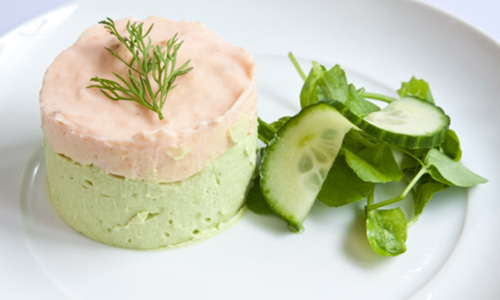
Ingredients for 4 servings:
- 120 g fresh salmon fillet
- 250 g cream
- 50 ml fish stock
- Salt, pepper
- 1 ripe avocado
- 2 tbsp double cream cheese
- 1-2 tbsp lemon juice
- 6 sheets of gelatine or 1 sachet (9 g) of powdered gelatine (for 500 ml of liquid)
In addition:
- Dill as a garnish
Preparation:
- Wash, pat dry and finely dice salmon fillet and freeze the diced fillet for approx. 30 minutes
- Soak gelatine in 2 separate bowls with 3 sheets per bowl or half a sachet. Whip cream and refrigerate. Purée diced salmon finely with an immersion blender, slowly adding the fish stock – stir in 1 tablespoon of cream
- Squeeze out 3 sheets of gelatine, dissolve lukewarm (or take swollen gelatine) and stir into the salmon cream. Then fold half of the cream into the mixture and season with salt and pepper
- Slice the avocado lengthwise, separate the two halves by rotating them in opposite directions and remove the avocado pit. Leaving the fruit in its skin, make cuts into the flesh of the avocado in a cross-hatch pattern and then remove the cubes with a tablespoon. Purée together with the cream cheese and lemon juice and also season with salt and pepper
- Squeeze out 3 sheets of gelatine, dissolve lukewarm (or take swollen gelatine) and stir into the avocado mixture and then fold in the remaining cream
- Fill both creams into small moulds (approx. 125 ml liquid) that have been rinsed with cold water and refrigerate for at least 2 hours
- To serve, unmould the small towers of cream and garnish with a sprig of dill. Goes well with a cucumber salad with watercress
Click here for more information on cooking and baking with gelatine.
Nutritional values per serving approx.:
- Calories: 380
- Joules: 1589
- Protein: 12.3 g
- Fat: 35.2 g
- Carbohydrates: 4.4 g
Avocado – slender and healthy with the green “butter pear”
Even though the nutty taste of the avocado is more reminiscent of a vegetable, it is in fact a berry. It grows on the avocado tree, which is a member of the laurel family. Avocados are picked from the tree unripe and then delivered in this condition to stores worldwide. If an avocado is already soft at the time of purchase, the avocado has probably been at the store for a while and may have been handled by any number of hands. For this reason it is recommended to buy hard avocados and let them finish ripening at home. A very simple trick can be used to achieve this: just wrap the avocado in newspaper together with an apple. The apple emits ethylene, a so-called ripening gas that promotes ripening in all fruits. Despite supplying approximately 220 calories and 23 g of fat per 100 g of fruit, avocados are not considered one of the classic fattening foods. The many unsaturated fatty acids they contain may even help to reduce fat. The enzyme lipase, which controls the burning of fat during digestion, plays a lead role in this. Moreover, the fatty acids they contain increase the proportion of so-called good cholesterol (HDL) in the blood and, in doing so, simultaneously flush the bad cholesterol (LDL) out of the arteries. Avocados are also full of vitamins A, C and E as well as the valuable B vitamins.In order to reach the delicious flesh of the avocado, slice the fruit lengthwise and separate the two halves by rotating them in opposite directions. It is best to use a sharp knife when removing the pit. However, do not throw it away. It contains special enzymes that ensure that the cut pieces of avocado will remain fresh longer and will not turn brown. It is best to use a spoon to scoop the fruit away from the avocado skin. To ensure that the cut pieces of avocado remain green, store them together with the pit or sprinkle them with lemon juice. The same applies to a leftover half that is not intended for immediate use. Wrap cling film around the avocado half and its pit and store in a cool place.